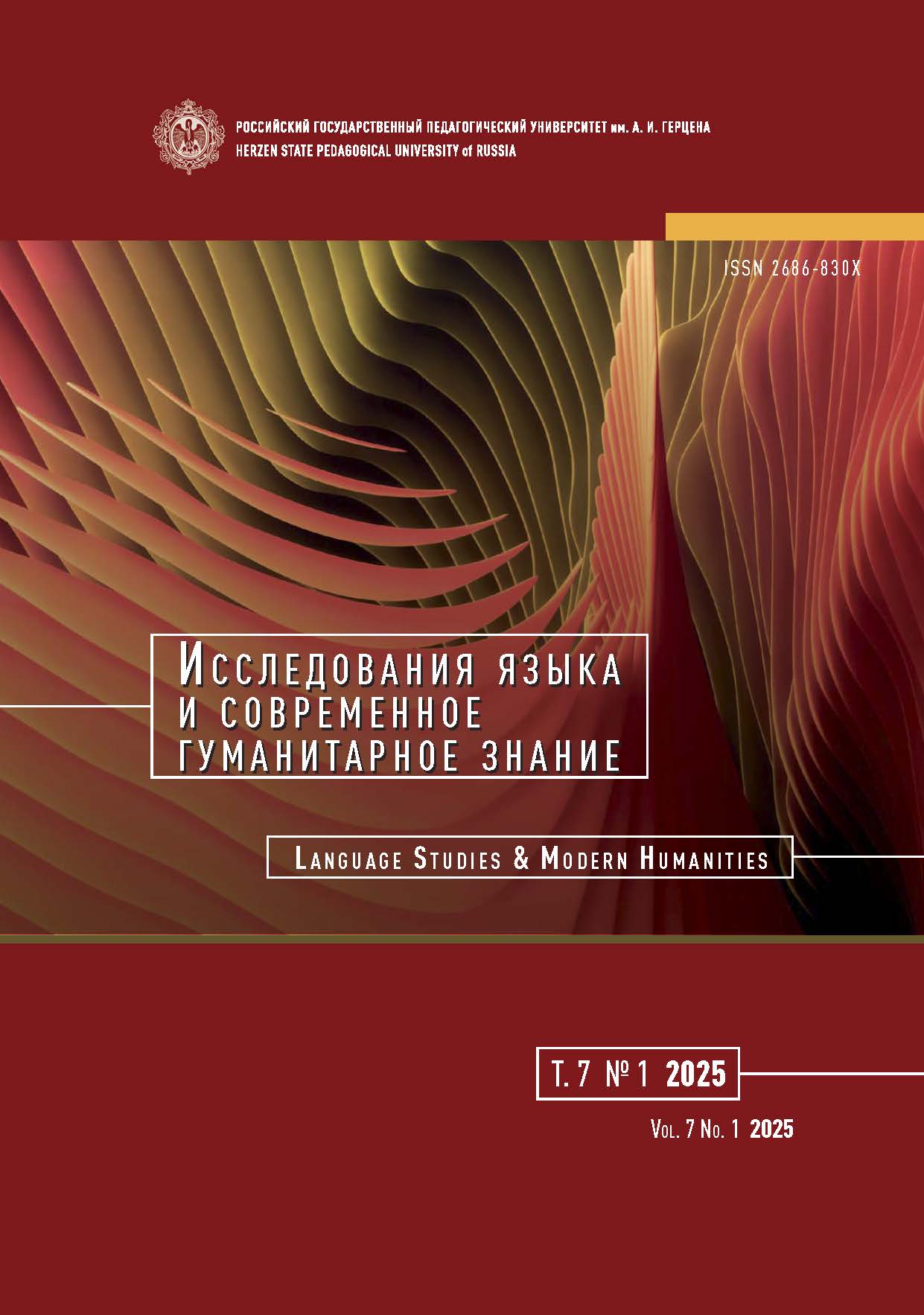“Strong” musical texts: Gaining primacy (from “Carmen” by P. Merimee to “Carmen” by J. Bizet)
DOI:
https://doi.org/10.33910/2686-830X-2025-7-1-37-44Keywords:
original text information inexhaustibility, primacy, secondarity, semiosis, transformation, translation multiplicityAbstract
The article addresses secondary verbal, non-verbal and not only verbal (hybrid) versions of a “strong” original of fiction, which in modern humanitarian discourse is understood as a text that has both indisputable high aesthetic and cultural value and a number of other mandatory parameters (wide popularity in “one’s own” and “foreign” cultures, inclusion in the programs of various levels of education and in national / world book ratings, regular high reinterpretability of its information by means of various semiotic systems). The research results allow us hypothetically propose a probability of existence in the cultural space of various regions and a whole world of a polysemiotic multicomponent center of translation attraction. The creation of secondary versions of an original (primary) text is due to the inherent ambiguity of its information and can be described in the light of such new categories of Literary Translation Studies as the inexhaustibility of the original (the potential possibility for a theoretically infinite number of a primary text interpretations) and translation multiplicity (the existence of an original text in numerous secondary forms). Translational multiplicity presupposes the translation of a verbal original text by means of “one’s own” language (intralingual translation type), “foreign” language (interlingual type) or “languages” of other semiotic systems (intersemiotic type). Under certain conditions, secondary versions can also obtain a status of a “strong” text (in the broad sense of text). The work examines the situation in which a verbal text of fiction becomes a “strong” musical text. The material under study were the relations between the verbal text of P. Merimee’s novella “Carmen” and the hybrid opera text of the same name by J. Bizet which have resulted into creation of the world culture unique supertext.
References
ЛИТЕРАТУРА
Виноградова, А. С. (2012) Рождение русской Кармен. Искусство музыки: теория и история, № 4, с. 88–98.
Ганзбург, Г. И. (2012) «Кармен». Либретто. Сопоставительная таблица переводов. [Электронный ресурс]. URL: https://classic-online.ru/uploads/000_notes/9000/8948.pdf (дата обращения 10.08.2024).
Гарбовский, Н. К. (2011) Новый перевод: свобода и необходимость. Вестник Московского университета. Сер. 22. Теория перевода, № 1, с. 3–16.
Кузьмина, Н. А. (2009) Интертекст: тема с вариациями. Феномены культуры и языка в интертекстуальной интерпретации. Омск: Изд-во ОмГУ, 228 с.
Разумовская, В. А. (2016) Центры переводной аттракции как результат переводной множественности «сильного» оригинала. В кн.: Русский язык в мировом контексте и международных организациях: Международный форум: Материалы конференции. М.: Форум, с. 348–356.
Разумовская, В. А. (2024) «Сверхтекст» как форма существования «сильного» художественного текста. Вестник Российского университета дружбы народов. Серия: Теория языка. Семиотика. Семантика, т. 15, № 1, с. 262–275. https://doi.org/10.22363/2313-2299-2024-15-1-262-275
Чеснокова, О. С. (2013) «Кармен» П. Мериме в парадигме интертекстуальности. Ученые записки Национального общества прикладной лингвистики, № 3 (3), с. 59–68.
Cadera, S. M., Walsh, A. S. (2022) Retranslation and Reception — a Theoretical Overview. In: Retranslation and Reception: Studies in a European Context. Approaches to Translation Studies. Vol. 49. Amsterdam; New York: Brill Publ., pp. 1–20. https://doi.org/10.1163/9789004517875_002
Christofordis, M., Kertesz, E. (2019) Carmen and the Staging of Spain. Recasting Bizet’s Opera in the Belle Epoque. New York: Oxford University Press, 328 p. https://doi.org/10.4000/transposition.3051
Dudley, E. J. (1997) The Endless Text: Don Quixote and the Hermeneutics of Romance (SUNY Series, Margins of Literature). Buffalo: State University of New York Press, 342 p.
Index Translationum: UNESCO Culture Sector. (2024) [Online]. Available at: https://www.unesco.org/xtrans/bsform.aspx (accessed 12.08.2024).
Prosper Merimee’s “Carmen and Other Stories” published in Persian. (2024) Tehran Times, February 17. [Online]. Available at: https://www.tehrantimes.com/news/495007/Prosper-Merimee-s-Carmen-and-Other-Storiespublished-in-Persian (accessed 18.08.2024).
Razumovskaya, V. A. (2019) A Center of Translation Attraction as the Tower of Babel Replica: Intersemiotic Translation Perspectives. Mundo Eslavo, no. 18, pp. 202–215.
Rowden, C., Smith, R. L. (2020) Carmen at Home and Abroad. In: Carmen Abroad: Bizet’s Opera on the Global Stage. Cambridge: Cambridge University Press, pp. 3–25. https://doi.org/10.1017/9781108674515.001
REFERENCES
Cadera, S. M., Walsh, A. S. (2022) Retranslation and Reception — a Theoretical Overview. In: Retranslation and Reception: Studies in a European Context. Approaches to Translation Studies. Vol. 49. Amsterdam; New York: Brill Publ., pp. 1–20. https://doi.org/10.1163/9789004517875_002 (In English)
Chesnokova, О. S. (2013) “Karmen” P. Merime v paradigme intertekstual’nosti [“Carmen” by P. Merimee in the intertextuality paradigm]. Uchenye zapiski Natsional’nogo obshchestva prikladnoi lingvistiki — Scientific Notes of the National Society of Applied Linguistics, no 3 (3), pp. 59–68. (In Russian)
Christofordis, M., Kertesz, E. (2019) Carmen and the Staging of Spain. Recasting Bizet’s Opera in the Belle Epoque. New York: Oxford University Press, 328 p. https://doi.org/10.4000/transposition.3051 (In English)
Dudley, E. J. (1997) The Endless Text: Don Quixote and the Hermeneutics of Romance (S U N Y Series, Margins of Literature). Buffalo: State University of New York Press, 342 p. (In English)
Ganzburg, G. I. (2012) “Karmen”. Libretto. Sopostavitel’naya tablitsa perevodov [“Carmen”. Libretto. Comparative table of translations]. [Online]. Available at: https://classic-online.ru/uploads/000_notes/9000/8948.pdf (accessed 10.08.2024). (In English)
Garbovskyi, N. K. (2011) Novyj perevod: svoboda i neobkhodimost’ [New translation: Freedom and necessity]. Vestnik Moskovskogo universiteta. Ser. 22. Teoriya perevoda — Moscow University Translation Studies Bulletin, no. 1, pp. 3–16. (In Russian)
Index Translationum: UNESCO Culture Sector (2024) [Online]. Available at: https://www.unesco.org/xtrans/bsform.aspx (accessed 12.08.2024).
Kuzmina, N. A. (2009) Intertekst: tema s variatsiyami. Fenomeny yazyka i kul’tury v intertekstual’noj interpretatsii [Intertext: The theme with variations. The language and culture phenomena in intertextual interpretation]. Omsk: Omsk State University Publ., 228 p. (In Russian)
Prosper Merimee’s “Carmen and Other Stories” published in Persian. (2024) Tehran Times, February 17. [Online]. Available at: https://www.tehrantimes.com/news/495007/Prosper-Merimee-s-Carmen-and-Other-Storiespublished-in-Persian (accessed 18.08.2024). (In English)
Razumovskaya, V. A. (2016) Tsentry perevodnoj attraktsii kak rezul’tat perevodnoj mnozhestvennosti “sil’nogo” originala [Centers of translation attraction as a result of the translation multiplicity of a “strong” original]. In: Russkij yazyk v mirovom kontekste i mezhdunarodnykh organizatsiyakh: Mezhdunarodnyj forum: Materialy konferentsii [Russian language in the global context and international organizations: International Forum: Proceedings of the conference]. Moscow: Forum Publ., pp. 348–356. (In Russian)
Razumovskaya, V. A. (2019) A Center of Translation Attraction as the Tower of Babel Replica: Intersemiotic Translation Perspectives. Mundo Eslavo, no. 18. Granada: Universidad de Granada, pp. 202–215. (In English)
Razumovskaya, V. A. (2024) “Supertekst” kak forma sushchestvovaniya “sil’nogo” khudozhestvennogo teksta [“Supertext” as a form of a “strong” fiction text existence] Vestnik RUDN. Seriya: Teoriya yazyka. Semiotika. Semantika — RUDN Journal of Language Studies, Semiotics and Semantics Language, vol. 15, no. 1, pp. 262–275. https://doi.org/10.22363/2313-2299-2024-15-1-262-275 (In Russian)
Rowden, C., Smith, R. L. (2020) Carmen at Home and Abroad. In: Carmen Abroad: Bizet’s Opera on the Global Stage. Cambridge: Cambridge University Press, pp. 3–25. https://doi.org/10.1017/9781108674515.001 (In English)
Vinogradova, A. S. (2012) Rozhdenie russkoj Karmen [The birth of Russian Carmen] Iskusstvo muzyki: teoriya i istoriya — Art of Music. Theory and History, no. 4, pp. 88–98. (In Russian)
Downloads
Published
Issue
Section
License
Copyright (c) 2025 Veronica A. Razumovskaya

This work is licensed under a Creative Commons Attribution-NonCommercial 4.0 International License.
The work is provided under the terms of the Public Offer and of Creative Commons public license Creative Commons Attribution 4.0 International (CC BY 4.0).
This license permits an unlimited number of users to copy and redistribute the material in any medium or format, and to remix, transform, and build upon the material for any purpose, including commercial use.
This license retains copyright for the authors but allows others to freely distribute, use, and adapt the work, on the mandatory condition that appropriate credit is given. Users must provide a correct link to the original publication in our journal, cite the authors' names, and indicate if any changes were made.
Copyright remains with the authors. The CC BY 4.0 license does not transfer rights to third parties but rather grants users prior permission for use, provided the attribution condition is met. Any use of the work will be governed by the terms of this license.







